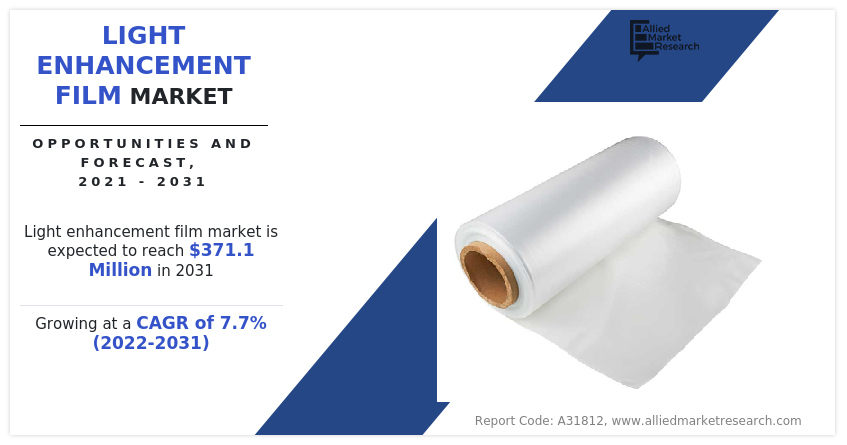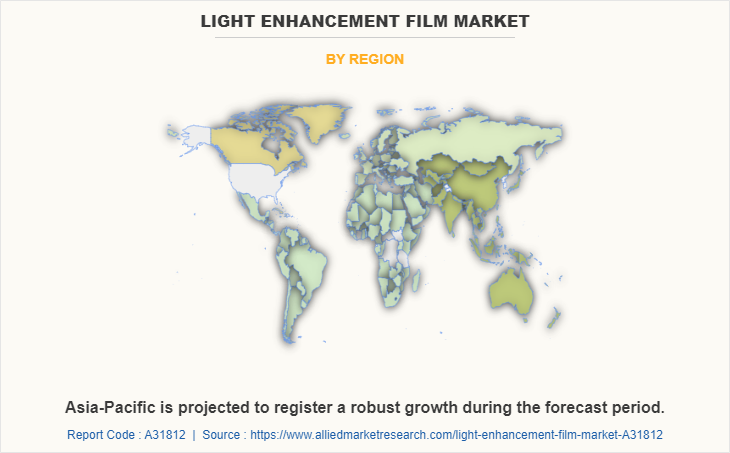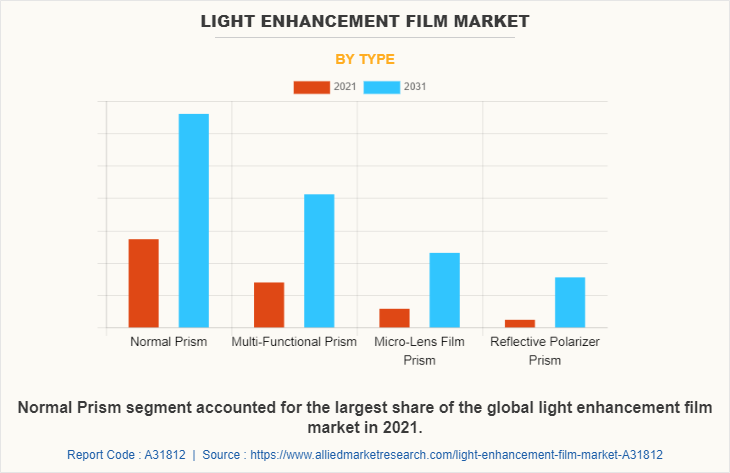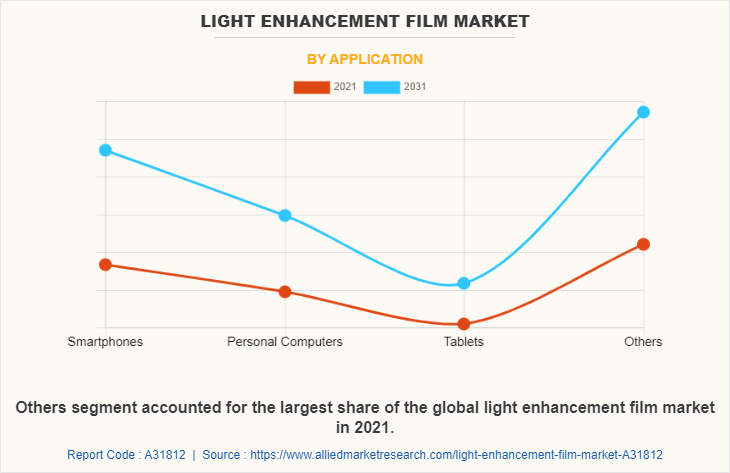Light Enhancement Film Market Research, 2031
The global light enhancement film market was valued at $178.1 million in 2021, and is projected to reach $371.1 million by 2031, growing at a CAGR of 7.7% from 2022 to 2031.
Report Key Highlighters:
- The light enhancement film market study covers 20 countries. The research includes segment analysis of each country in terms of value ($million) for the projected period 2021-2031.
- Both primary and secondary research is conducted in order to gain a better understanding of the market. A broad array of industry sources for our secondary include company SEC filings, annual reports, company websites, broker and financial reports, and investor presentations, regional government and statistical databases for macro analysis, authentic news articles, etc.
- The light enhancement film market is highly fragmented, with several players including 3M, Boyd, Fusion Optix, Kessler Optics and Photonics Solutions, Luminit, LLC., Mitsubishi Chemical Corporation, NITTO DENKO CORPORATION, Rina Technology Co.,Ltd., Riverdi Sp. z o.o., and Yongtek. Also tracked key strategies such as acquisitions, product launches, mergers, expansion etc. of the players operating in light enhancement film market.

Light enhancement film is used to enhance the brightness of liquid crystal display backlights (LCD). The increased brightness can be converted into power efficiency or heat dissipation. Brightness enhancement films are widely used in the design and manufacture of OLED and big TV panels. To adjust the exit angle of the light, brightness enhancement films employ a micro repeated prismatic structure. Light-enhancement film LED displays are employed in these commercial spaces mostly for promotional purposes that are appealing to customers. The huge screen that shows material with dazzling colors and loud sound entices people to see the content. Most multiplexes are introducing high-definition LED displays to broadcast videos and movies as part of paid ads for their clients.
Surge in adoption of smartphones and display control panels is predicted to drive the global light enhancement film market growth during the forecast period
Smartphone has dramatically transformed the lives of individuals. It has evolved into a pocket-sized computer where the display of a smartphone refers to the screen technology, resolution, size, and pixel density. The market is predicted to develop as demand for high-end smartphones outpaces demand for mid-range and low-end smartphones. Furthermore, the manufacturers provide a variety of features in the smartphone that make it more attractive to use in applications that need Thin Film Transistor liquid crystal display (TFT LCD) or in-plane switching liquid crystal display (IPS LCD).
Furthermore, an advanced capacitive screen in a typical control display with the conductive touch and an advanced resistive screen is constructed of two thin layers of additional polyethylene terephthalate (PET) covered with indium tin oxide (ITO). Global smartphone sales are predicted to increase in the future years as a result of the implementation of 5G networks, increased disposable income in developing countries, and a global rising population. On September 8, 2022, Apple released the iPhone 14, which had battery life and camera advancements over its predecessor. Its four new versions have bigger displays ranging in length from 6.1 to 6.7 inches and a more powerful CPU.
Liquid Crystal Display (LCD) technology is gaining popularity because it is more energy efficient and provides greater image quality than previous technologies. As flat panel display technology is gaining popularity in the educational system, flat panel display manufacturers are producing interactive flat panel displays.
The emergence of multi-touch displays, faster replacement cycles, and changing consumer usage patterns are projected to fuel display panel growth throughout the forecast period. Increasing demand in the automotive industry, technical improvements, and government initiatives toward smart cities are all contributing to the worldwide display panel growth. Display panel demand from AR/VR, military, and security is boosting the display panel industry.
The light enhancement film market is segmented into type, application, and region. On the basis of type, the market is categorized into normal prism, multi-functional prism, micro-lens film prism and reflective polarizer prism. On the basis of application, market is categorized into smartphones, personal computers, tablets, and others. Region wise, the light enhancement film market share is studied across North America, Europe, Asia-Pacific, and LAMEA.

Asia-Pacific dominated the light enhancement film industry. In Asia-Pacific, light enhancement films are mostly employed as antireflection coatings for camera lenses and cold mirrors for lightning. It is employed in a variety of industries, including automotive, medical, home electric appliances, and light exposure. Light enhancement film helps in the regulation of refraction, allowing for a clean image. The increasing use of the Internet of Things (IoT) in government institutes, academic institutes, and offices is increasing the demand for light enhancement films throughout Asia-Pacific.
Light enhancement films are highly utilized in television in Asia-Pacific due to their qualities such as greater brightness, improved contrast, and increased durability. They are more energy-efficient and easier to read in direct sunshine. They are also utilized in polarization recycling optics, which boosts backlight efficiency in LCDs and may be used to reduce energy consumption, extend battery life, or improve brightness.

The normal prism segment accounted for the largest share of the global light enhancement film market in terms of revenue, in 2021. Normal prism is often used in telescopes, binoculars, submarine periscopes, and microscopes. Spectroscopes use prisms to separate the energy emitted by light sources such as stars. The best prism material is BAK4, or Barium Crown glass. It has a higher refractive index and a lower critical angle than other materials, which means it transmits light better and loses less light owing to internal reflection for example, from internal bubbles trapped during the manufacturing process.
Furthermore, prism glasses are typically recommended by eye physicians to patients who suffer from double vision, blurred vision, migraines, or other symptoms caused by minor eye misalignment. Prism correction helps to align human eyes so that one can only see a single clear picture. For instance, Lenskart launched 73 outlets in 19 Indian states in January 2022 and announced plans to build 400 more. Thus, the increase in demand for normal prism is expected to boost the light enhancement film market during the forecast period.

The other applications of light enhancement film market include LCD panel, TVs, Notebooks, and, LED lighting systems. These segments collectively accounted for the largest share of the global light enhancement film market in terms of revenue, in 2021. Display panel manufacturers are continually improving their products as factors such as increased consumer electronics production create a large market for display panels. TFT (Thin Film Transistor) is an active-matrix LCD with better picture quality in which one transistor controls the lighting of the display, allowing for comfortable viewing even in bright situations. For instance, Samsung has announced the launch of its Neo QLED TV with an ultra-premium product line, which boasts true-to-life image quality and a bezel-less infinity one design to provide customers with a cinematic watching experience.
Furthermore, light enhancement film manufacturers are working toward a solution that can deliver a power yield of greater than 80%, which dual brightness enhancement films can provide which are highly demanded in notebooks, and LED lighting systems. The commercialization of LED graphic displays is driving the use of LED display control cards, as well as laptops and notebooks. The power consumption of a laptop is determined by the screen size; normally, power consumption ranges from 20 to 100 watts while running on battery power.
Major players operating in the global light enhancement film market includes 3M, Boyd, Fusion Optix, Kessler Optics and Photonics Solutions, Luminit, LLC., Mitsubishi Chemical Corporation, NITTO DENKO CORPORATION, Rina Technology Co.,Ltd., Riverdi Sp. z o.o., and Yongtek.
Historical Trends:
LED lighting technology was created in the 1960s by a General Electric scientist named Nick Holonyak. Some believe lasers will eventually replace LEDs because they are more compact, create up to 1,000 times more light, and use just one-third of the power.
In 1974, light enhancement is frequently attributed to neural transients that occur immediately after stimulus initiation. This attribution presumes an equivalency between the whole of a stimulus's reaction and the instantaneous response at a particular time following stimulus initiation.
Toshiba released E Series LEDs in 2000, which employ a novel reflector material to produce a 50% brightness boost while minimizing Infrared radiation (IR) emissions.
In 2008, LED lights started to become popular in schools, offices and hospitals. Lights are the primary source of illumination, and halogen and fluorescent bulbs are being phased out. LED lighting can convert around 70% of energy into light, but conventional lighting loses a significant amount of energy by converting it to heat.
In 2020, light enhancement film began to be employed in the form of LEDs for displays, keypad or display backlighting, and so on. Bright white LEDs can also be used as spotlights and flashes for mobile phones.
Key Benefits For Stakeholders
- This report provides a quantitative analysis of the market segments, current trends, estimations, and dynamics of the light enhancement film market analysis from 2021 to 2031 to identify the prevailing light enhancement film market opportunities.
- The market research is offered along with information related to key drivers, restraints, and opportunities.
- Porter's five forces analysis highlights the potency of buyers and suppliers to enable stakeholders make profit-oriented business decisions and strengthen their supplier-buyer network.
- In-depth analysis of the light enhancement film market segmentation assists to determine the prevailing market opportunities.
- Major countries in each region are mapped according to their revenue contribution to the global market.
- Market player positioning facilitates benchmarking and provides a clear understanding of the present position of the market players.
- The report includes the analysis of the regional as well as global light enhancement film market trends, key players, market segments, application areas, and market growth strategies.
Light Enhancement Film Market Report Highlights
| Aspects | Details |
| Market Size By 2031 | USD 371.1 million |
| Growth Rate | CAGR of 7.7% |
| Forecast period | 2021 - 2031 |
| Report Pages | 207 |
| By Type |
|
| By Application |
|
| By Region |
|
| Key Market Players | Mitsubishi Chemical Corporation, Riverdi Sp. z o.o., 3M, Boyd, Yongtek, Kessler Optics and Photonics Solutions, Fusion Optix, NITTO DENKO CORPORATION, Rina Technology Co.,Ltd., Luminit, LLC. |
Analyst Review
According to the opinions of various CXOs of leading companies, the light enhancement film market is driven by its rising use in the design and production of LCD and large TV screens. It can distribute light at a 70-degree angle in the front, but it can also reuse light beyond the view angle to its exquisite micro-structure optical film.
Moreover, Asia-Pacific is projected to register a robust growth during the forecast period. Light enhancement films are used in television in Asia-Pacific, due to their properties such as enhanced brightness, improved contrast, and increased durability. In Asia-Pacific, light enhancement films are utilized in goods such as halogen, compact fluorescent, and incandescent lighting.
The outbreak of COVID-19 has affected the economies and industries of various countries due to repeated government blockades, travel bans, supply chain disruptions, and sudden business closures. However, growing work-from-home facilities created an opportunity for the light enhancement market players where smartphones, laptops, tablets and personal computer are used has contributed to the growth of the light enhancement film market in the Asia-Pacific region.
The light enhancement film market was valued $178.1 million in 2021 and is estimated to surpass $371.1 million by 2031, exhibiting a CAGR of 7.7% from 2022-2031.
Rising adoption of smartphones and display control panels and growing demand for electronics appliances are the key drivers of Light Enhancement Film Market.
Smartphones is the leading application of Light Enhancement Film Market.
Asia-Pacific is the largest regional market for Light Enhancement Film.
Top companies to hold the market share in Light Enhancement Film include 3M, Boyd, Fusion Optix, Kessler Optics and Photonics Solutions, Luminit, LLC., Mitsubishi Chemical Corporation, NITTO DENKO CORPORATION, Rina Technology Co.,Ltd., Riverdi Sp. z o.o., and Yongtek.
Loading Table Of Content...



